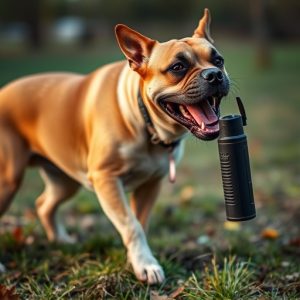Outdoor Safety: Decontaminating Your Pet After Pepper Spray Exposure
Dog pepper spray, containing capsaicin, causes temporary blindness and respiratory distress. Proper…….
Dog pepper spray, containing capsaicin, causes temporary blindness and respiratory distress. Proper decontamination after exposure is vital using warm water, mild soap, and gentle washing. Seek veterinary care for inhalational distress. Transfer of spray between animals necessitates careful practices. Regular fur decontamination with specialized shampoos prevents lingering effects. Non-lethal alternatives offer safe training and protection options. Always decontaminate pets after Mace exposure.
“Ensure your pet’s safety outdoors with a comprehensive understanding of dog pepper spray and its potential risks. This article guides you through critical knowledge about this controversial tool, offering insights into its effects on canine health. Learn essential steps to decontaminate your pet after exposure to mace, including immediate care and thorough washing techniques. Additionally, explore preventative measures and alternative solutions for outdoor safety, empowering you to make informed decisions while safeguarding your four-legged companion.”
- Understanding Dog Pepper Spray and Its Potential Risks
- Steps to Decontaminate Your Pet After Exposure
- Preventative Measures and Alternative Solutions
Understanding Dog Pepper Spray and Its Potential Risks
Dog pepper spray, also known as mace for dogs, is a controversial tool designed to deter aggressive or unwanted canine behavior. It’s important to understand that this product isn’t just a mild irritant; it contains capsaicin, the compound responsible for the burning sensation in chili peppers. When used, dog pepper spray can cause temporary blindness, coughing, difficulty breathing, and extreme discomfort, making it a powerful chemical agent.
While it may be effective in certain situations, there are significant risks involved, particularly if not handled properly. In case of exposure, decontaminating your pet becomes crucial. This process involves thoroughly rinsing the affected areas with warm water to remove any residual spray. If your dog inhales the spray, seek immediate veterinary care as it can lead to respiratory distress. Additionally, remember that pepper spray can transfer from fur to human skin or other animals, necessitating careful decontamination practices to avoid further irritation or complications.
Steps to Decontaminate Your Pet After Exposure
After your dog has been exposed to pepper spray, decontaminating them properly is crucial to ensure their safety and well-being. Start by removing any visible remnants of the spray from your pet’s fur using warm water and a mild, fragrance-free soap. Gently wash their face, paws, and body, paying close attention to areas where the spray may have concentrated, like the eyes, nose, and mouth. Rinse thoroughly with clean water to remove all traces of the irritant.
Post-wash, you should dry your dog gently using a soft towel. If possible, use an eye wash solution or saline spray to irrigate any affected eyes, following the instructions provided by the vet. Monitor your pet for any signs of discomfort or adverse reactions and seek veterinary care if needed. Regularly check their coat for any lingering effects and repeat the decontamination process as necessary until all symptoms subside.
Preventative Measures and Alternative Solutions
Preventative measures are key when it comes to outdoor safety for both you and your dog. Regularly decontaminating their fur after walks in areas where pepper spray might be present is an effective strategy. This involves using specialized shampoos or solutions designed to remove any residual chemicals, ensuring your pet remains safe from potential irritation or health risks.
Exploring alternative solutions beyond traditional pepper spray is another proactive approach. There are non-lethal, dog-specific deterrents available that utilize different principles, such as taste or scent deterrents, which can be equally effective in discouraging aggressive behavior without causing harm. These alternatives offer a safer and more humane option for training and protection while minimizing the risk of adverse reactions.
While outdoor adventures with your dog can be exhilarating, it’s crucial to remember that unexpected encounters may arise. Dog pepper spray, while a deterrent, carries potential risks and should be used judiciously. In the event of exposure, promptly decontaminating your pet is essential. This process involves rinsing the affected areas thoroughly with water and seeking veterinary care if symptoms persist. To mitigate future incidents, consider alternative solutions like positive reinforcement training and natural deterrents. Remember, preventing encounters is often safer and more effective than relying solely on pepper spray. By combining awareness, decontamination knowledge, and preventative measures, you can ensure a safer and more enjoyable experience for both you and your four-legged companion.


